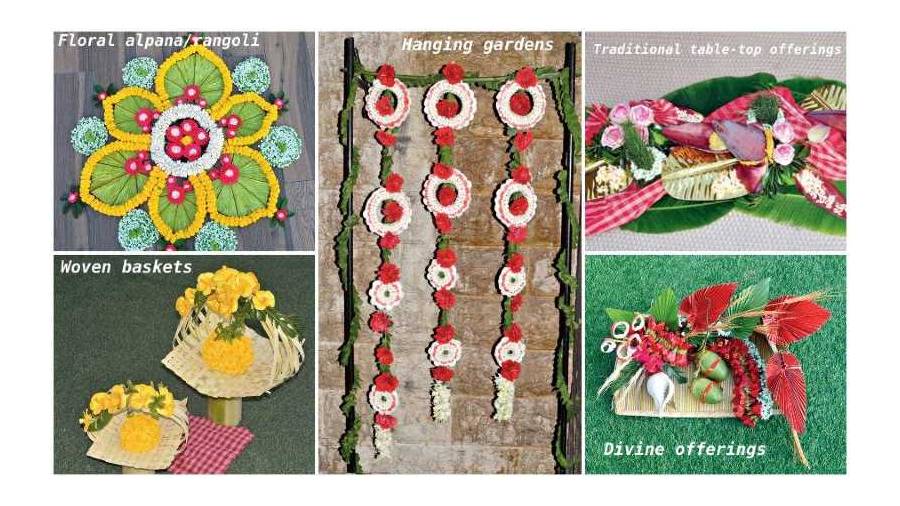Durga Puja celebrates the victory of the Goddess Durga over the demon King Mahishasura. It begins with Mahalaya, the same day as the start of Navratri, a nine-night festival celebrating the divine feminine. Durgotsava or Sharadotsava is traditionally celebrated in Bihar, West Bengal, Assam, Odisha, Tripura and Bangladesh as well.
Flowers are an integral part of Durga Puja. One hundred and eight lotus flowers signify the 108 names of Goddess Durga. The flowers that are believed to be the dearest to her are red hibiscus, red kana, lotus, marigold, champa and jasmine. Most of these DIY flower arrangements are largely adorned with these above-mentioned flowers.
WOVEN BASKETS
Dried talpata (tal palm leaves) are cut into equal-width strips and woven and a simple basket is created. In ancient times, the talpata was used to create pata chitra in Odisha. Two similar baskets of different sizes are woven. A moist oasis is fixed or glued at the centre. A medium-size marigold cluster is fixed in the oasis and appears ‘larger than life’ in terms of visual weight. Parallel large flowers are attached to the curved line of the handle of the basket.
Shola (pith) flowers are painted yellow and attached with Ixora and Xanadu leaves commonly available in the market. Shola is a dried milky white spongy plant matter from Aeschynomene aspera species and can be pressed and shaped into objects of choice. It is commonly used in eastern India. This is finished with green button chrysanthemum embellishments. A group of two to three such baskets liven up the living room during the festival.
HANGING GARDENS
India has a beautiful tradition of welcoming guests with bandarwar all over the country. A wrought iron stand with these beautiful latkans made of shola rings with fresh flowers and leaves is constructed to allow the ease of hanging this lightweight looping and winding arrangement. Thin shola rolls are cut in the shape of flower petals and coloured and pasted on each other. Shola buds, which are easily available in the market, are pasted symmetrically on them, creating volume on the circular floral design. Fresh contrasting bright red carnations are attached at equal distances to create an illusion of floral abundance. Sundari green creepers entwine the iron stand all over with a dense cluster of chikoo leaves at the bottom of the stand adding further distinction.
A bunch of rajnigandha latkans are suspended at the end of each hanging, giving off a beautiful fragrance that’s pleasing to the senses.
DIVINE OFFERINGS
Bamboo supli or the bamboo kulo — a lightweight yet strong, skillfully woven structure with a little depth and rims to hold all ceremonial essentials, is the base of this design. This auspicious kulo is offered to Ma Durga with all the offerings very dear to her. Hibiscus and jui mala is paired with fresh green baby coconuts with muli thread — a must in all puja offerings. The white conch that creates the divine sound of purity is placed next to it. The shankha signifies brilliance, purity and auspicious beginnings. China palm leaves are trimmed — some with natural green colour and a few with bright red to create a bright colour scheme which visually lifts the design. Xanadu leaves and wheat stalks are added to provide textural contrast. The good news is that all these contents are available in local markets and allow further creativity.
FLORAL ALPANA/ RANGOLI
Brightening up the festival celebration, the floral alpana is believed to be a harbinger of good luck. This symmetrical design starts from the central circular rajnigandha mala filled with small pink shola lotus flowers on a base of chikoo leaves. Red-and-white is a typical puja combination in Bengal. Large lotus leaves of different sizes are placed outside this circle. The periphery is lined with a yellow marigold mala dotted with smaller shola lotus flowers inside and outside the bordering line. They add a touch of colour variation in this attractive floor design. Thin jui flower garland are used to create large dots with green button chrysanthemums and it creates an abundance and additional interest. Go ahead and experiment with different repetitive forms and ingredients.
TRADITIONAL TABLE-TOP OFFERINGS
This table-top floral design relates to both the outline shape of the overall design and the shapes within the outline. The components in this design are each unique and distinguishable. The silhouette of each component interpretation is sculptured from traditional consideration. The placement of fresh large banana leaves creates elongated flow. The metallic ones add to the ornamentation in this massed traditional composition. Pink large banana flowers and open leaves stand out visually. The band of jui flowers around a bunch of durba grass is strategically and alternately placed throughout the length. The tiny shiuli flowers provide a hint of contrast in this rustic design. Repeated use of pink lotus adds to the drama and the long red-and-white checkered gamchha cloth creates a path of movement and greater impact that aids visual interest.
This can be used as console or dining table-top design. One can light a few fragrant incense sticks or tiny candle terracotta pots for further variation.
Sunita Kanoria, trained at Pushpa Bitan, is a judge for national-level flower-arrangement competitions, and currently utilises her time and talent as a floral-decor demonstrator at various forums
